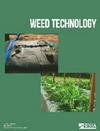Impact of Soil-Residual Herbicides on Industrial Hemp (Cannabis sativa L.) Phytotoxicity and Biomass Yield in West Texas
IF 1.7
3区 农林科学
Q3 AGRONOMY
引用次数: 0
Abstract
Industrial hemp is a multipurpose crop cultivated for fiber, seed, human food, and animal feed. Hemp legalization in Texas creates a considerable potential to increase its acreage in semi-arid conditions; however, knowledge to grow hemp optimally in Texas is limited. Best management practices, including weed control, need to be evaluated for profitable hemp production. Since little is known about the herbicide tolerance of hemp, field studies were conducted to test several soil-residual herbicides with different modes of action for phytotoxicity to two hemp cultivars, Yuma and Jinma. The experimental units were randomized three times in a blocked split-plot design with hemp cultivars in the main plots and soil-residual herbicides in the subplots. Ethalfluralin, the mixture of sulfentrazone and土壤残留除草剂对西得克萨斯州工业大麻(大麻)植物毒性和生物量产量的影响
工业大麻是一种多用途作物,可用作纤维、种子、人类食物和动物饲料。德克萨斯州的大麻合法化为增加其在半干旱条件下的种植面积创造了巨大潜力;然而,在德克萨斯州以最佳方式种植大麻的知识却很有限。需要对最佳管理方法(包括杂草控制)进行评估,以确保大麻生产有利可图。由于对大麻的除草剂耐受性知之甚少,我们进行了田间研究,以测试几种具有不同作用模式的土壤残留除草剂对两个大麻栽培品种尤马和金马的植物毒性。实验单位采用三次随机分组设计,大麻栽培品种位于主区,土壤残留除草剂位于副区。与未处理的对照相比,乙草胺、磺草酮和 S-甲草胺的混合物、丙草胺和 S-甲草胺在 2021 年和 2022 年的除草效果分别为 60% 至 90% 和 73% 至 100%。乙草胺和 S-甲草胺除草剂的大麻发芽率、株数和株高最高;但与未处理的对照组相比,大麻发芽率和株高没有显著差异。与未处理的对照相比,S-甲草胺、乙草胺、福美双和扑草净产生的大麻生物量相似。总之,研究结果表明,大麻对乙草胺、扑草净和 S-甲草胺具有耐受性,这些土壤残留除草剂能有效控制大麻中的杂草。应避免使用bicyclopyrone和S-metolachlor、metribuzin和S-metolachlor以及mesotrione的混合物,因为它们会对大麻植物造成严重伤害。未来的研究需要测试不同的苗前和苗后除草剂的功效,这些除草剂可用于在不同环境下种植的工业大麻,并确保大麻中的δ-9-四氢大麻酚(THC)含量低于法定含量限制。
本文章由计算机程序翻译,如有差异,请以英文原文为准。
求助全文
约1分钟内获得全文
求助全文
来源期刊

Weed Technology
农林科学-农艺学
CiteScore
2.90
自引率
21.40%
发文量
89
审稿时长
12-24 weeks
期刊介绍:
Weed Technology publishes original research and scholarship in the form of peer-reviewed articles focused on understanding how weeds are managed.
The journal focuses on:
- Applied aspects concerning the management of weeds in agricultural systems
- Herbicides used to manage undesired vegetation, weed biology and control
- Weed/crop management systems
- Reports of new weed problems
-New technologies for weed management and special articles emphasizing technology transfer to improve weed control
-Articles dealing with plant growth regulators and management of undesired plant growth may also be accepted, provided there is clear relevance to weed science technology, e.g., turfgrass or woody plant management along rights-of-way, vegetation management in forest, aquatic, or other non-crop situations.
-Surveys, education, and extension topics related to weeds will also be considered
 求助内容:
求助内容: 应助结果提醒方式:
应助结果提醒方式:


